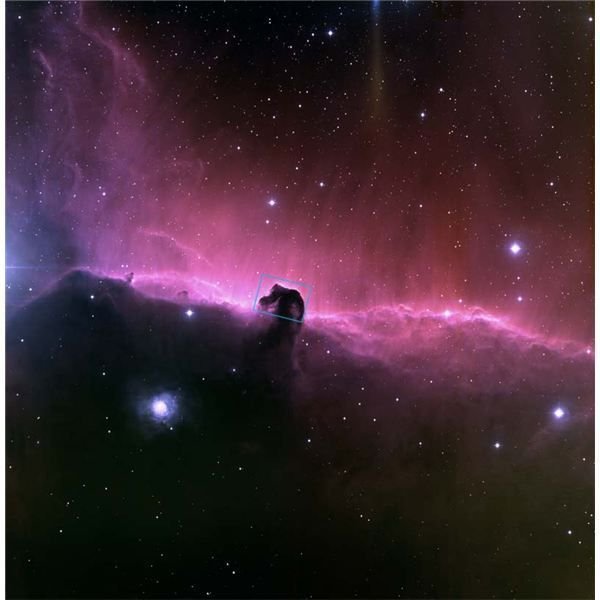Facts About the Dark Horsehead Nebula in the Constellation Orion
Some Basics
Barnard 33 is in the constellation Orion, which is best seen in the northern hemisphere during the winter. The nebula is about 1,550 light years from here, and it’s dimensions are about 2.7 x 18 light years. It’s rather far out at the edge of the galaxy with respect to the Sun, but can be seen with a 10 inch telescope with a hydrogen beta filter.
What many people who see pictures of the Nebula don’t realize is that it’s not pointing north, but pointing west. In other words, if you were on the Enterprise and approaching this huge area of space, its famous horse’s head shape would be lying on its side. And it probably wouldn’t look too much like a horsehead. Rotate it 90°, and the horse’s head appears!
Discovery
Barnard 33 was discovered by the astronomer Williamina Fleming. She was not only a woman astronomer, which was rare in 1881, but came to the profession by accident. Fleming was born in Scotland and moved with her husband to the United States as a young woman. When her husband left her while she was pregnant, she was hired as the maid of Harvard professor Edward Charles Pickering, who was also the director of the college’s observatory. Later, he hired Fleming as a sort of secretary at the observatory. She was ultimately hired to catalogue stars when Pickering grew disgusted with his slacking male assistants and claimed Fleming, a mere housekeeper, could do better than they could. He was right.
Fleming invented a system where she catalogued stars depending on the hydrogen in their spectra. The spectrum is a band of color into which the light of a star can be separated. They’re the colors of the rainbow: red, orange, yellow, green, blue, indigo and violet. The mnemonic used to remember this spectrum is name, ROY G BIV. Molecules, atoms and ions radiate most strongly at certain colors.
Fleming found more than 10,000 stars, as well as other deep space objects. These stars were later grouped into the Henry Draper Catalogue. Of course, for a long time Fleming’s boss, Mr. Pickering, got the credit for her work. She discovered Barnard 33, or the Horsehead Nebula in 1888, on plate B2312.
Dark Nebula
The nebula is a dark, or absorption nebula, which means that it’s a cloud that is so dense that it blocks out or absorbs the light of the glowing emission nebula behind it, in this case IC 434. Nebulae, from the Greek word for “cloud,” are made of gas and tiny dust particles enclosed in shells of nitrogen and carbon monoxide ice. The temperature of a nebulae is about 10 degrees K. This temperature is so cold that scientists speculate that the nebula will eventually collapse in on itself, and the pressures generated will begin the ignition of proto-stars.
Both IC 434 and Barnard 33 are part of the Orion Molecular Cloud and join a group of beautiful nebulae in the belt of Orion. Molecular Clouds are clouds found in outer space that are dense enough to allow molecules to form. Some of the molecules are water, ammonia, formaldehyde, acetylene, methyl alcohol, methyl cyanide, vinyl cyanide, formic acid and others. A molecular cloud can be from 104 to 106 times the mass of the Sun and they often shroud developing stars, like the shells of eggs around embryos. Other nebulae in the molecular cloud besides the Barnard 33 are the Orion Nebula, Barnard’s Loop, M78 and the Flame Nebula.
Barnard 33 is visually near the star Alnitak, though in reality the star is about 700 to 800 light years closer than the nebula. Alnitak is really three stars in the easternmost part of Orion’s Belt. The primary is a very hot O class supergiant whose diameter is at least 20 times larger than the Sun’s.
IC 434
IC 434, the emission nebula the Horsehead Nebula sits in front of, is pinkish red and glows because of ionized hydrogen gas. A hydrogen molecule is ionized when it’s so hot that electrons are added or removed from it. The nebula is pinkish because hydrogen glows with the most intensity at the red end of the spectrum. Because a nebula like IC 434 is made mostly of ionized hydrogen, it’s called an H II region. These regions are commonly the cradles of some extremely hot O and B stars. This would be called an O-B association. In the case if IC 434, the hydrogen is being heated by the multiple star system Sigma Orionis, whose primary stars are a Sigma Orionis AB, a young O-B association. Together, they’re about 32,500 times as luminous as the Sun.
References
eSky: Horsehead Nebula, https://www.glyphweb.com/esky/nebulae/horsehead.html
The Horsehead Nebula, https://www.noao.edu/image_gallery/html/im0057.html
WFleming, https://www.womanastronomer.com/wfleming.htm
Kaufmann III, William J. Universe: W.H. Freeman and Company, Fourth Edition. 1994
Schaaf, Fred. The 50 Best Sights in Astronomy and How to See Them. Wiley, 2007
This post is part of the series: Nebulae, Globular Clusters, Supernovae and Other Faraway Things
This series is an exploration of the beautiful and fascinating objects of deep space.
